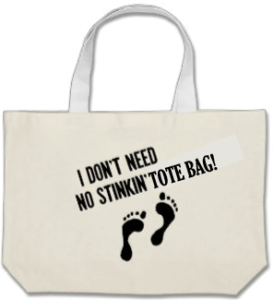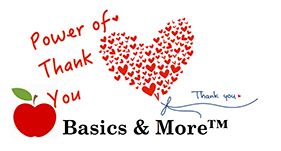 I often say “if you want gifts, you must give them.”
I often say “if you want gifts, you must give them.”
I want to “clairify” that I mean this somewhat metaphorically.
I mean you shouldn’t focus only on getting, but also on giving.
Your relationship with your donors shouldn’t be all take, take, take.
That being said, most donors don’t want a lot of “stuff.” They particularly don’t want expensive and/or useless stuff. In other words, you don’t have to give them tangible gifts of tote bags, coffee mugs and socks. Instead, consider giving them “gratitude experiences.”
What the Research Shows
In fact, an interesting study by Yale School of Management found that thank-you gifts reduce charitable donations.
Organizations believe that offering thank-you gifts increases charitable donations, but they actually reduce donation amounts.
–George Newman, Yale School of Management.
In a series of experiments across different charities and types of gifts, they found that offering a gift reduced donation amounts across the board, regardless of whether the donations were hypothetical or real, the gift was more or less valuable or the charity was familiar or unfamiliar.
The authors attribute the decrease in donations to what they call the “crowding out” effect. In other words, offering a gift to a donor in exchange for their gift may “crowd out” the good feelings a donor gets from giving.
The presence of an external motivation like a gift may undermine people’s altruistic motivations to donate.
–George Newman, Yale School of Management
The study does not suggest that thank you gifts are bad in all cases. Nor do I.
For example, they found that offering a logo item while suggesting that using it will raise awareness of the charity did increase donations. It did not, however, increase donation size.
What I’ve Learned from Practice
General research is interesting, and a good place to begin, but you’ve got to test this for your organization. Constituencies differ.
When I worked in an arts organization, people appreciated gifts and benefits. They enjoyed getting a lapel pin with a musical note. Or being invited to a fancy cocktail party.
My next job was with a social services agency. I tried to introduce similar gifts and benefits for different levels of giving. I created Giving Societies, and the more you gave the more benefits you got.
It was a complete failure!
My development committee was willing to bow to my expertise. I went ahead and ordered some cute lapel pins with our logo (less than $1/each). Some donors liked them and enjoyed having me pin them on them at events. But… ultimately, I bowed to the committee’s expertise. They told me:
Donors to social services want all their money to go directly to programs. They don’t want you to buy them gifts or give them parties. So many organizations give me pins, and I never wear them! It’s a waste.
Nadine Rushakoff, Board member, Jewish Family and Children’s Services
They were right. Instead, I started giving them little tokens — not as incentives, but after they gave — that showed I was thinking about them.
- I baked them cookies (I love to bake!), and hand-delivered these to donors when they made a major or legacy gift.
- I sent them clippings of articles I thought they’d enjoy (this was pre-internet).
- I sent them certificates when they reached milestones (e.g., 10 years of giving).
- I invited them on tours of our different sites.
- I invited them to special volunteer activities created just for them.
- I enclosed stickers in their thank you letters so they could give them to their kids and explain why they had received them (thereby teaching the next generation about philanthropy).
- I ordered them freebies from Vista Print (e.g., personalized note pads or fridge magnets with their name on them)
Over the years I developed a broad array of what I call little “Wows.” Things that just make donors feel all warm and fuzzy and pleasantly surprised.
I’ve found these little, unexpected gifts can go a long way towards building essential personal relationships with your donors.
But there’s something that builds the relationship even further!
The Value of Offering Donor Experiences
You may have heard that acquiring “stuff,” in the long run, does not make us as happy as acquiring memories. Memories created from experiences.
So why not put away your catalogues of swag items and instead consider the types of experiences you have to offer?
Donors want to know their gifts made a real impact and helped them create the change they hoped to see. If you can reassure them they made a great decision in giving to you, that’s the true gift.
Not a keepsake they’ll tuck away in a drawer and forget about more or less immediately.
Some of the experiences I’ve found work well are:
- Behind-the-scenes tours
- Brown bag discussions with program directors
- Mock decision-making sessions with program directors, where donors are asked to decide how they would allocate limited resources among different beneficiaries.
- Book groups where folks discuss readings related to the cause.
- Performances by clients (e.g. students)
- Client presentations
- Volunteer activities
What are some terrific donor experiences you’ve created? Please share in the comments below.
Want More on Creative Ways to Thank Your Donors?
 Get Creative Ways to Thank Your Donors. It’s an e-workbook with everything you need to knock your donors’ socks off!
Get Creative Ways to Thank Your Donors. It’s an e-workbook with everything you need to knock your donors’ socks off!
 Better yet, get the complete 4-week “Power of Thank You‘ e-course. I only offer it once/year, and it happens to begin this year on May 2nd. Clairification school members can sign up here. Not yet a member? Enroll in Clairification School to get the student discount here, You’ll then also get all Clairification School benefits for a full year.
Better yet, get the complete 4-week “Power of Thank You‘ e-course. I only offer it once/year, and it happens to begin this year on May 2nd. Clairification school members can sign up here. Not yet a member? Enroll in Clairification School to get the student discount here, You’ll then also get all Clairification School benefits for a full year.






Agree totally!! I have started sending back the reply envelopes withut $$$ but with a note saying “Do NOT send me notepads, address labels, calendars…or ANYTHING! Please spend my gift money on those folks that need it.! That’s why I give to you!”
Thanks Marguerite. After-the-fact token gifts, invitations and thoughtful, personalized content are much appreciated, and very different. They show that you know me. 🙂